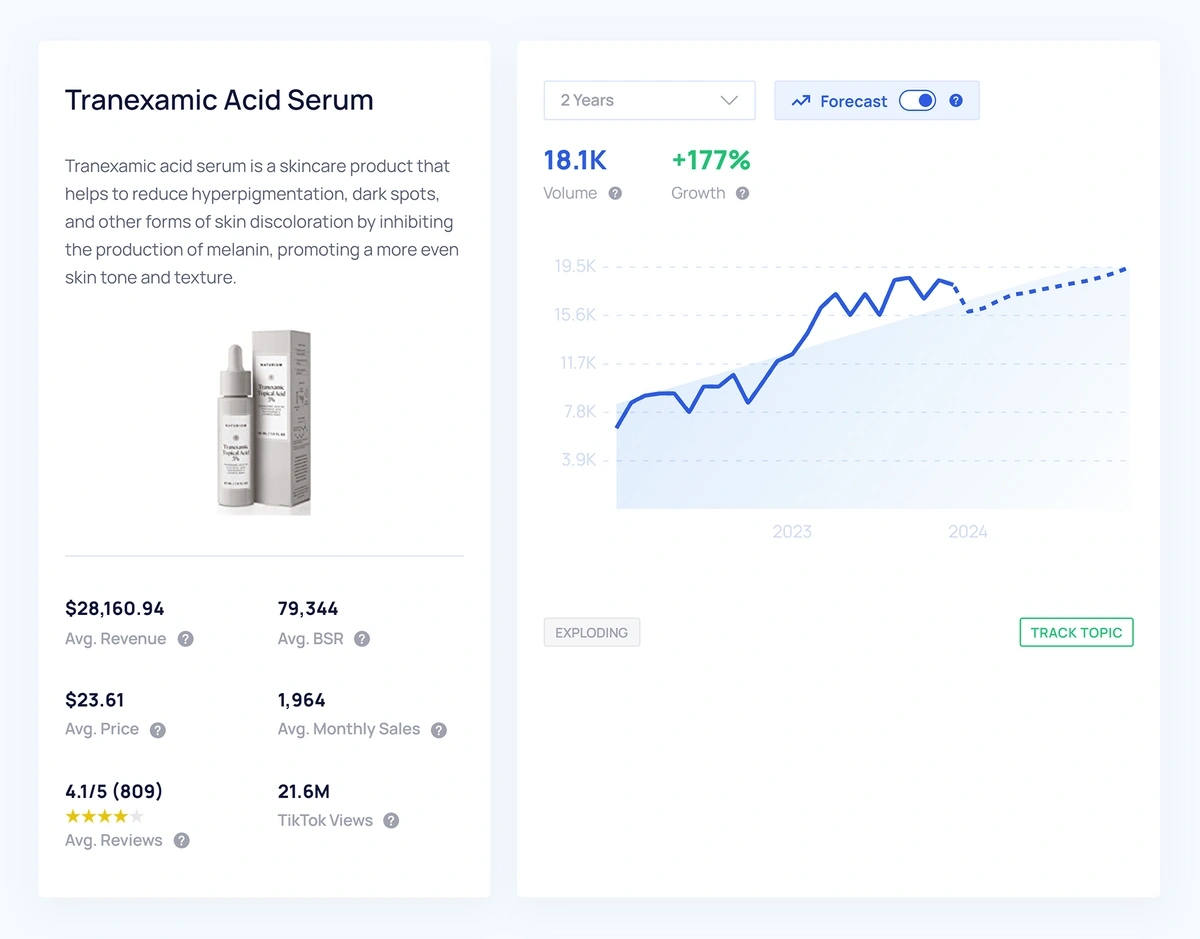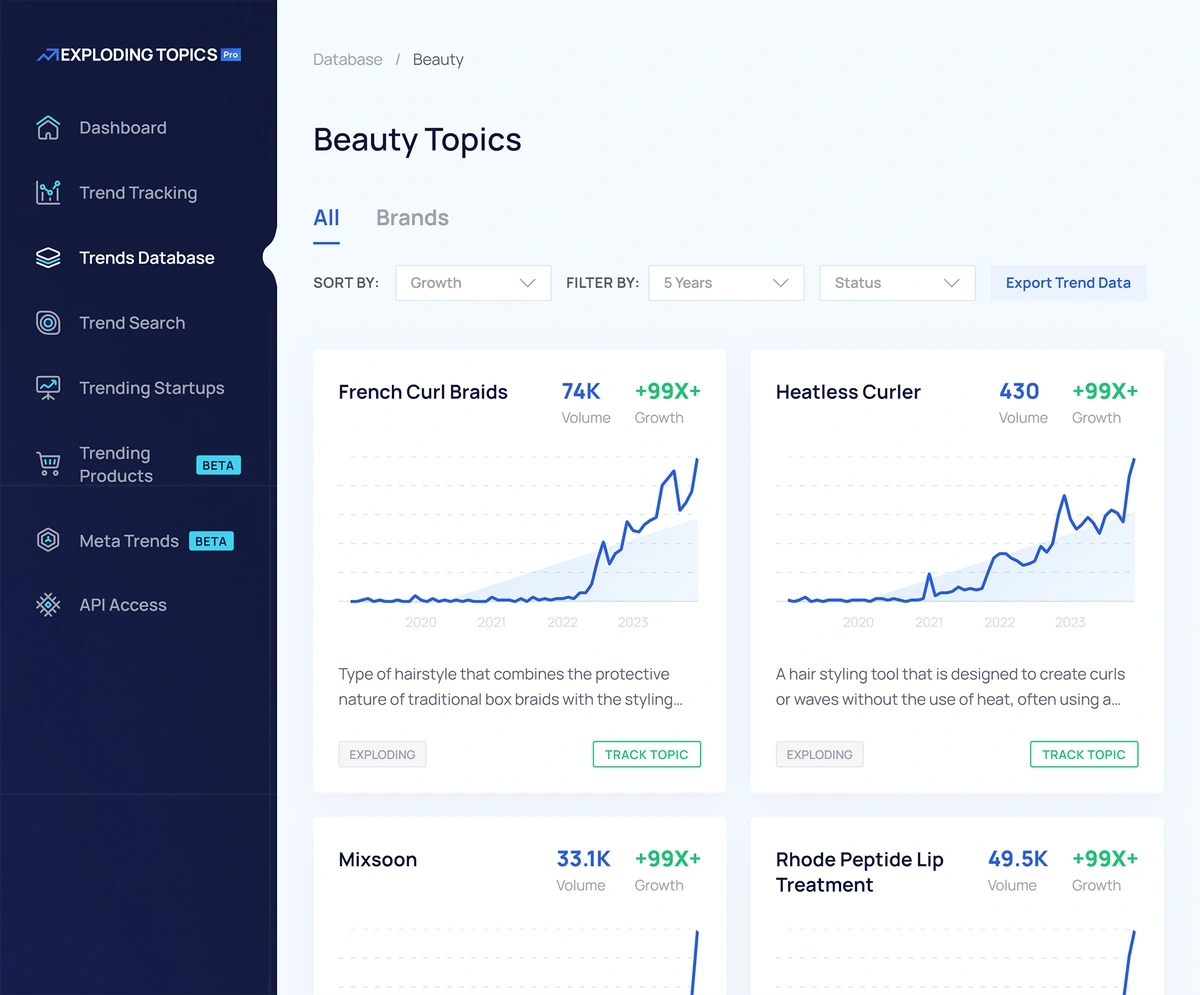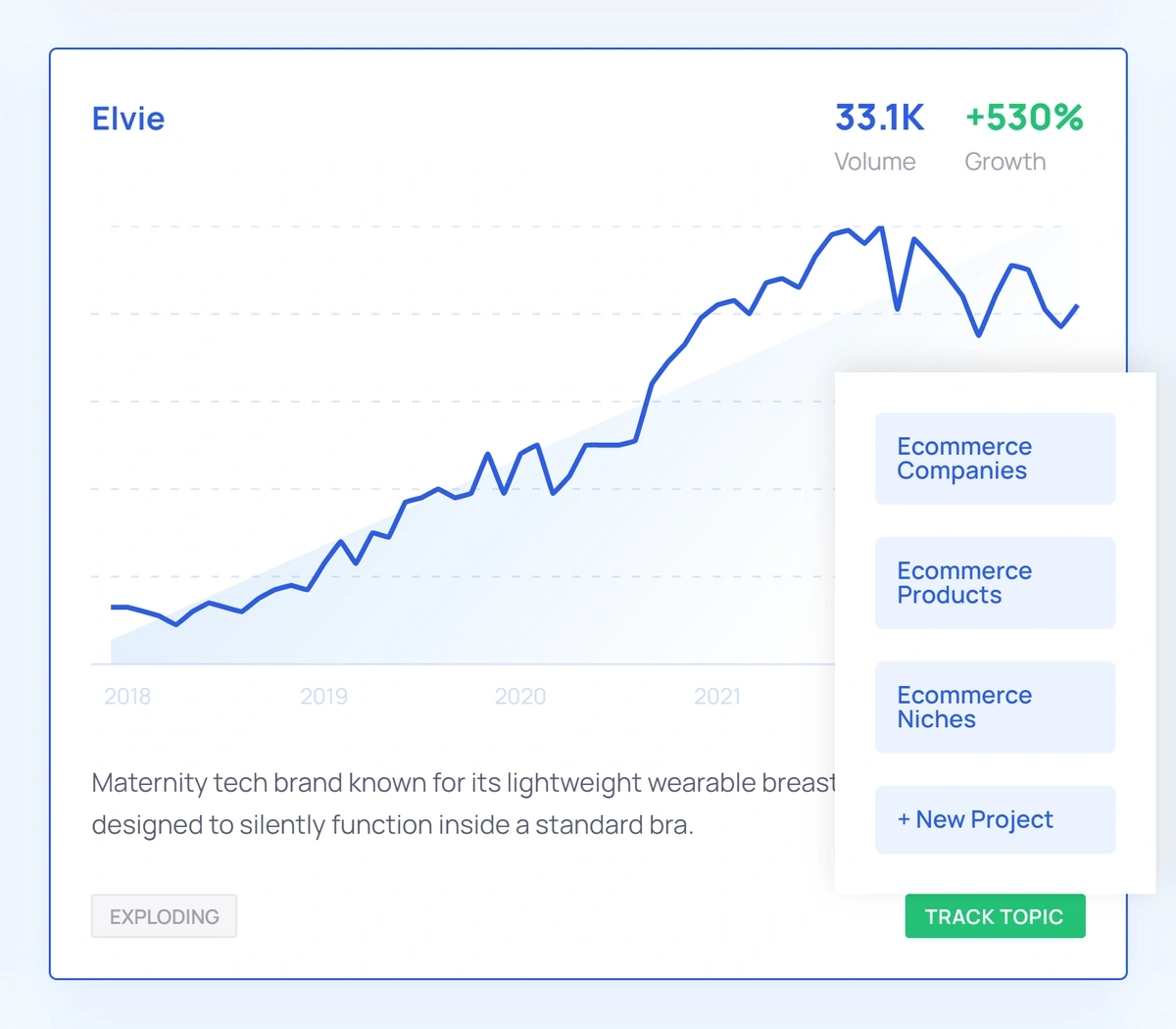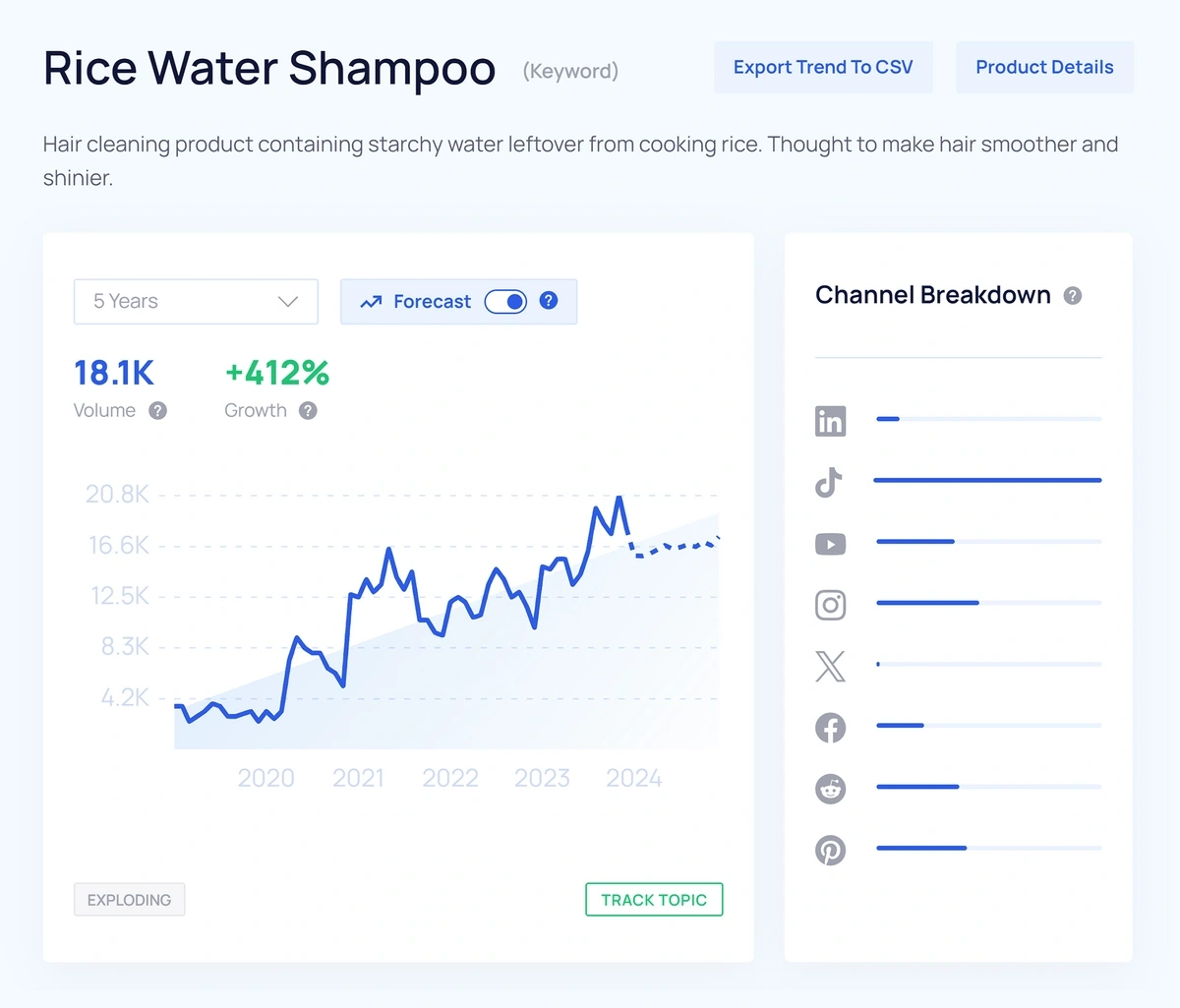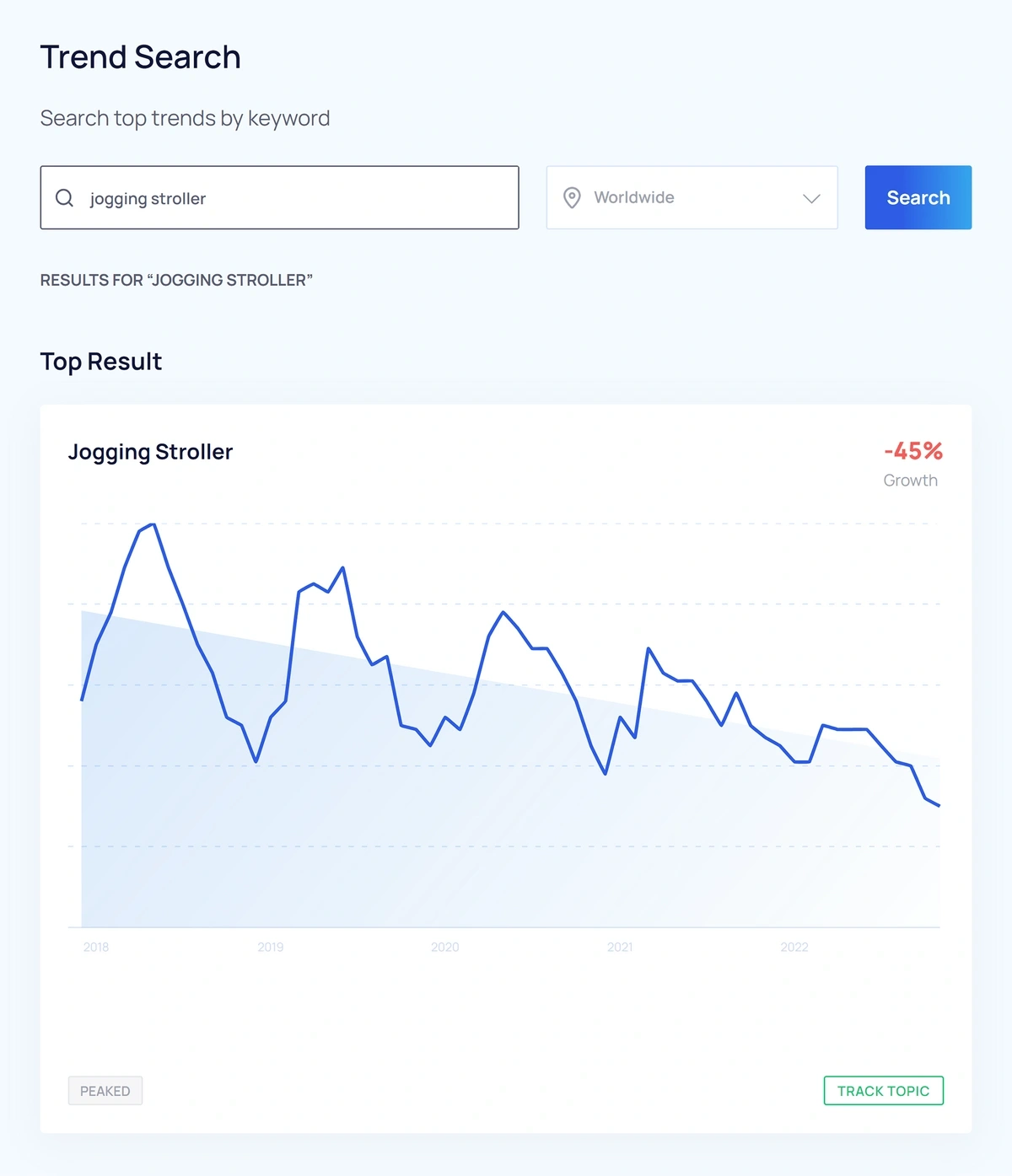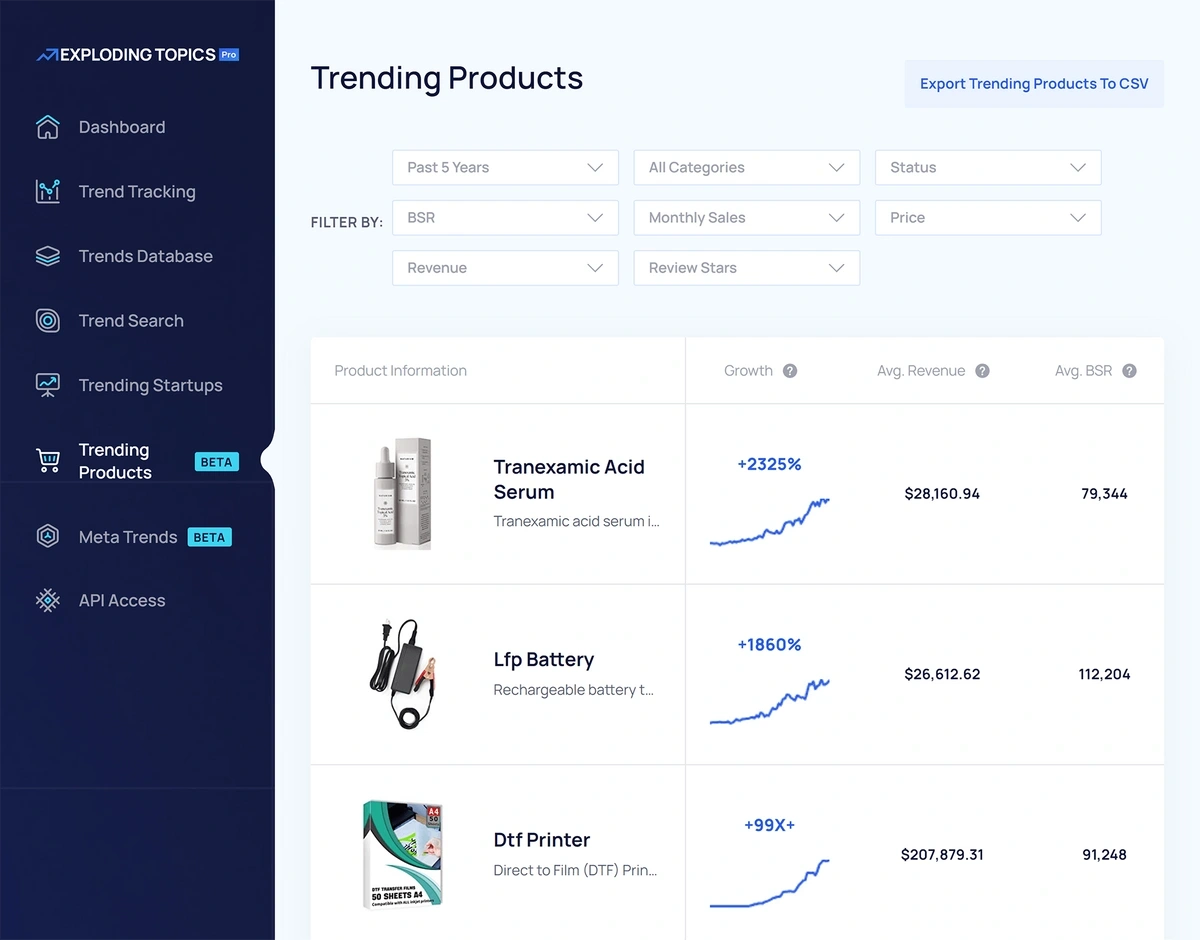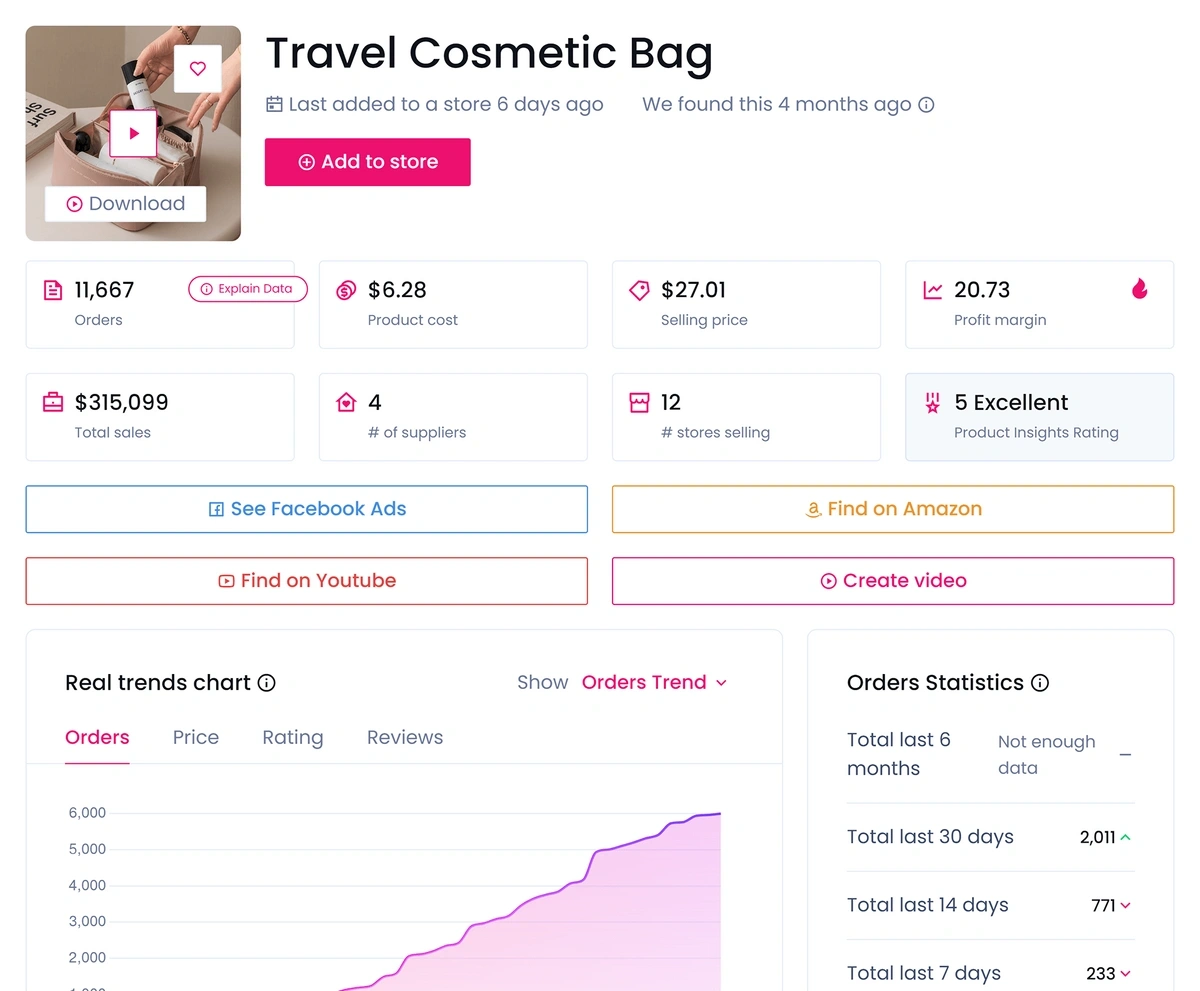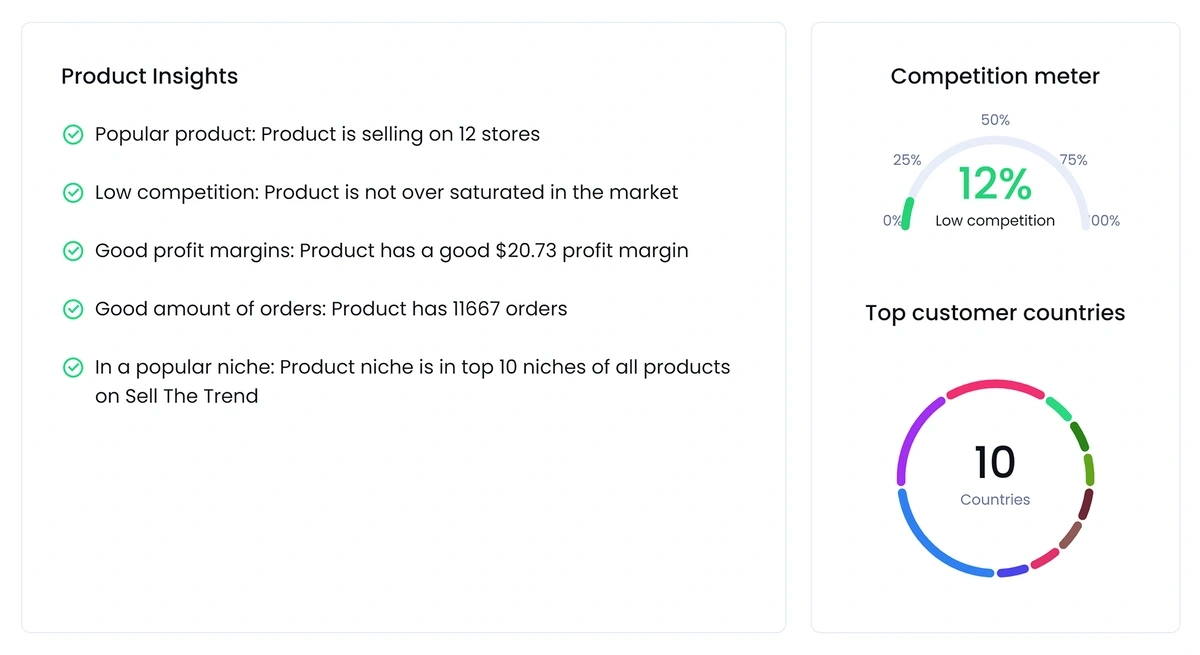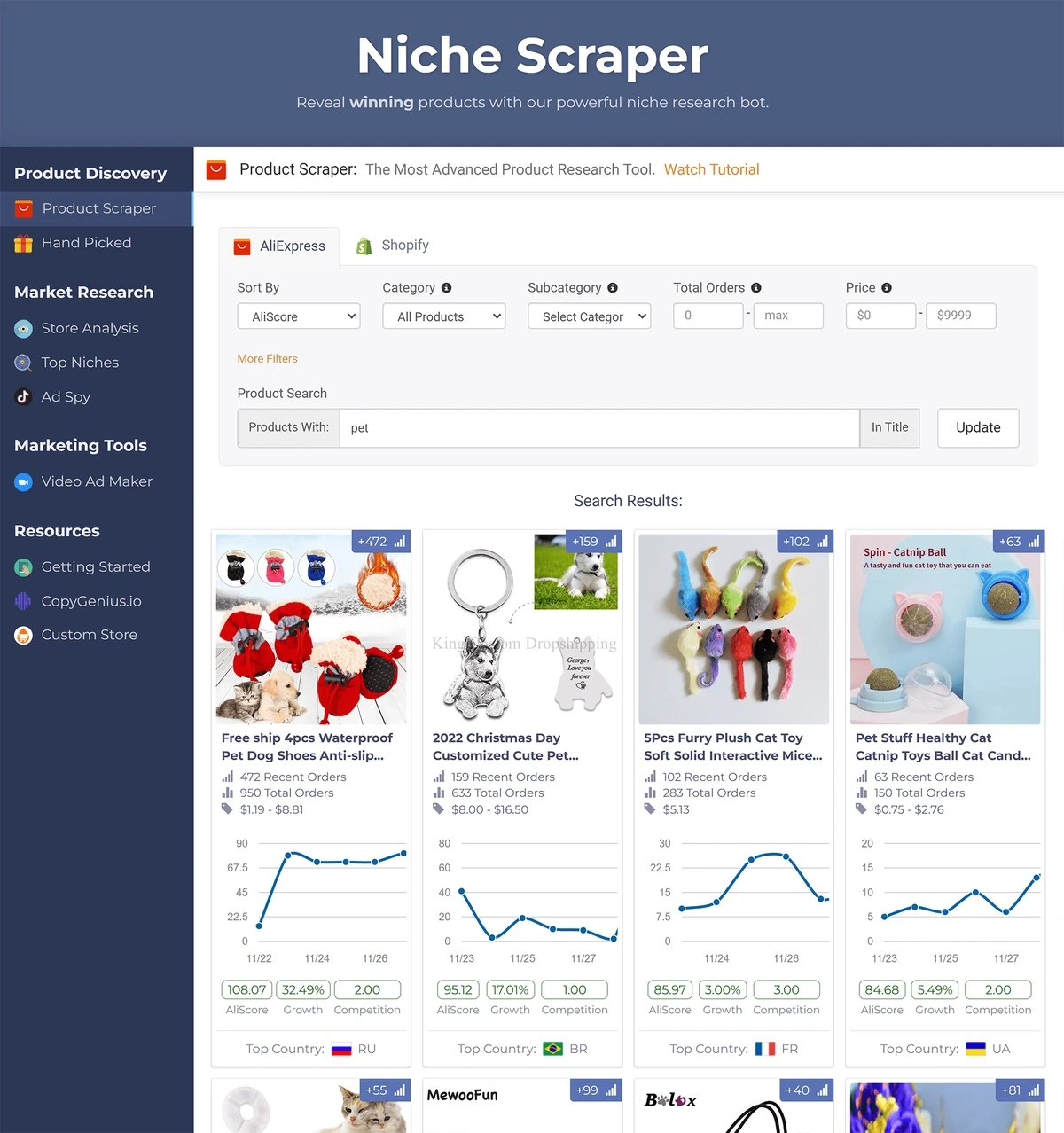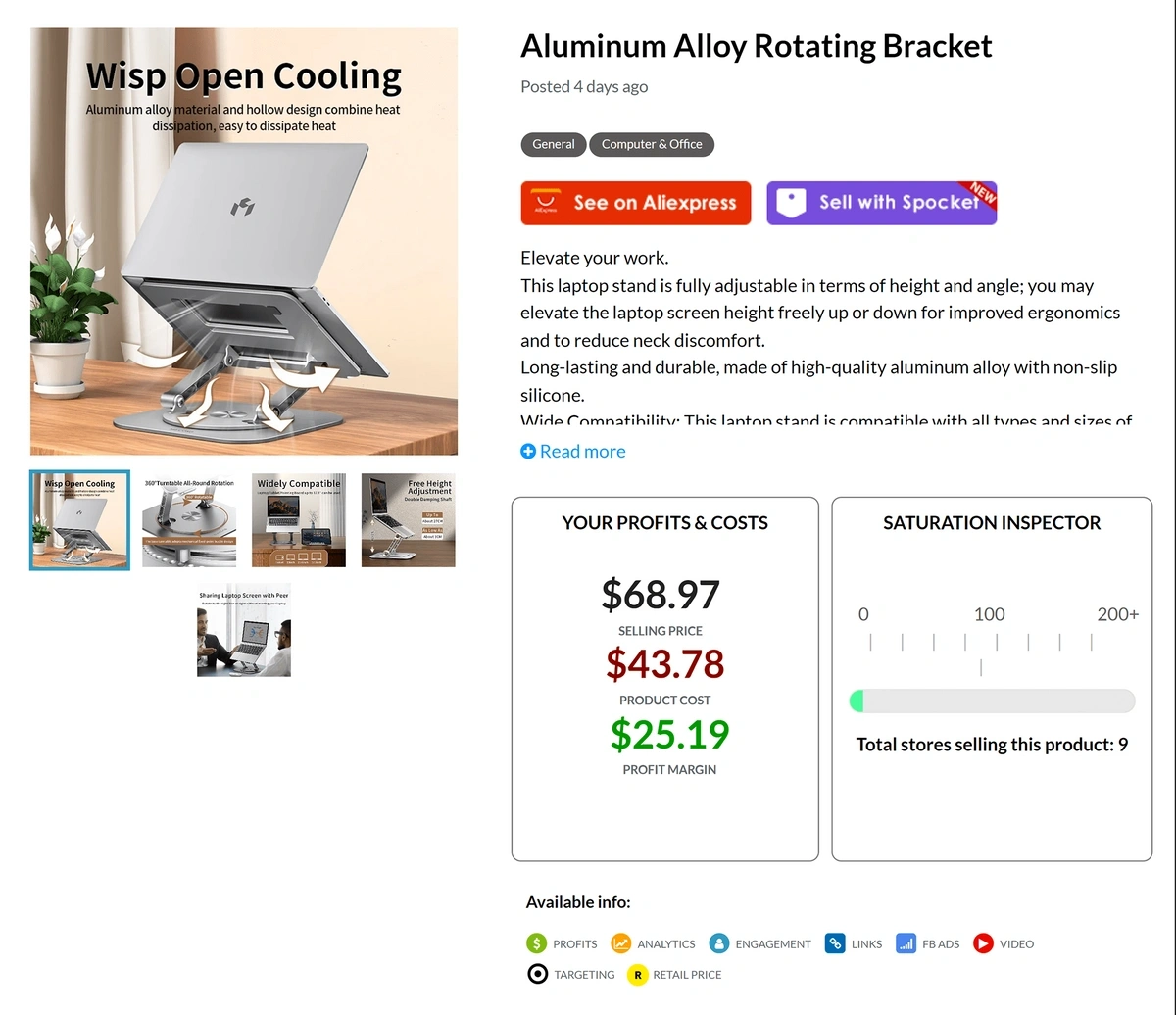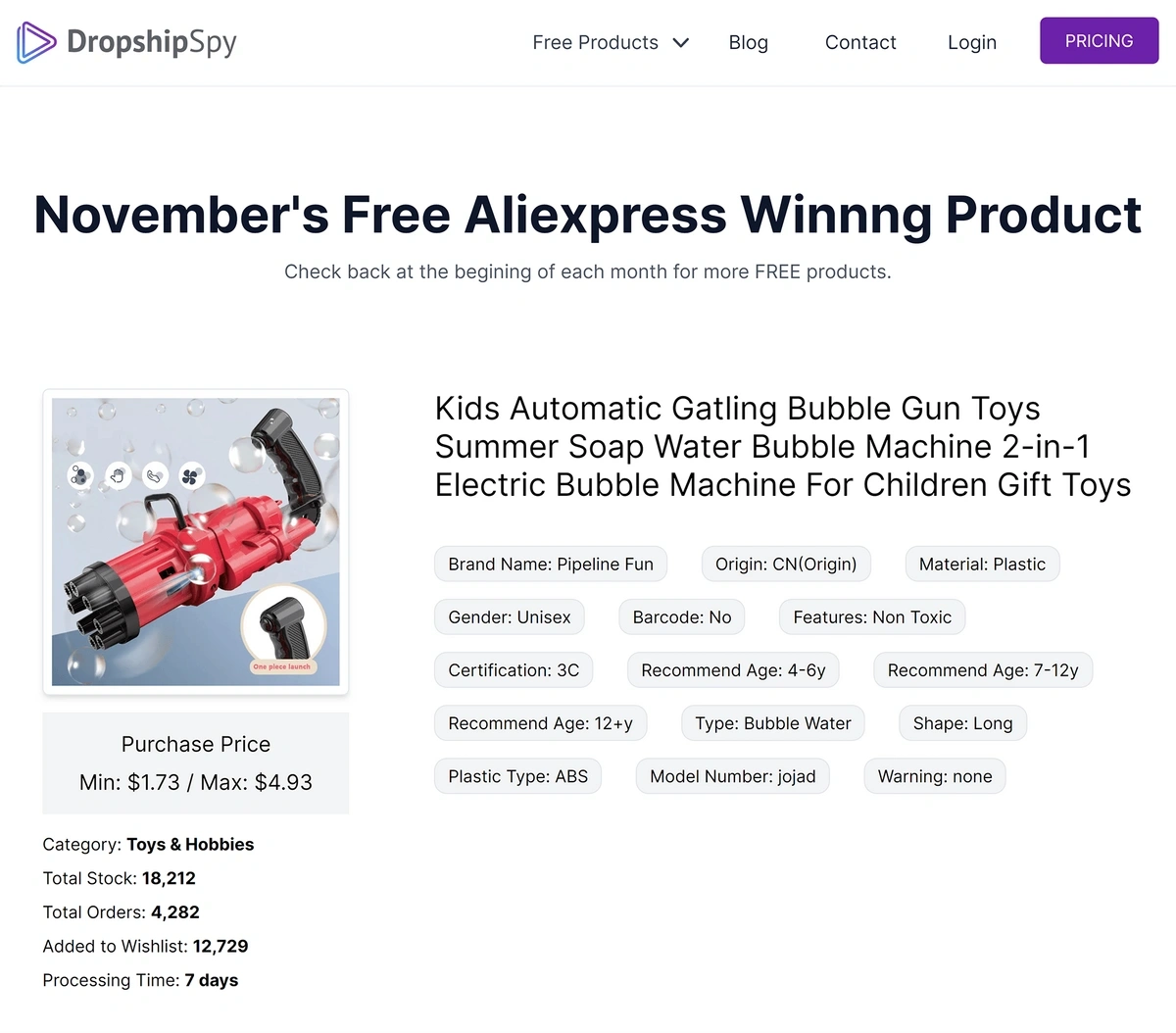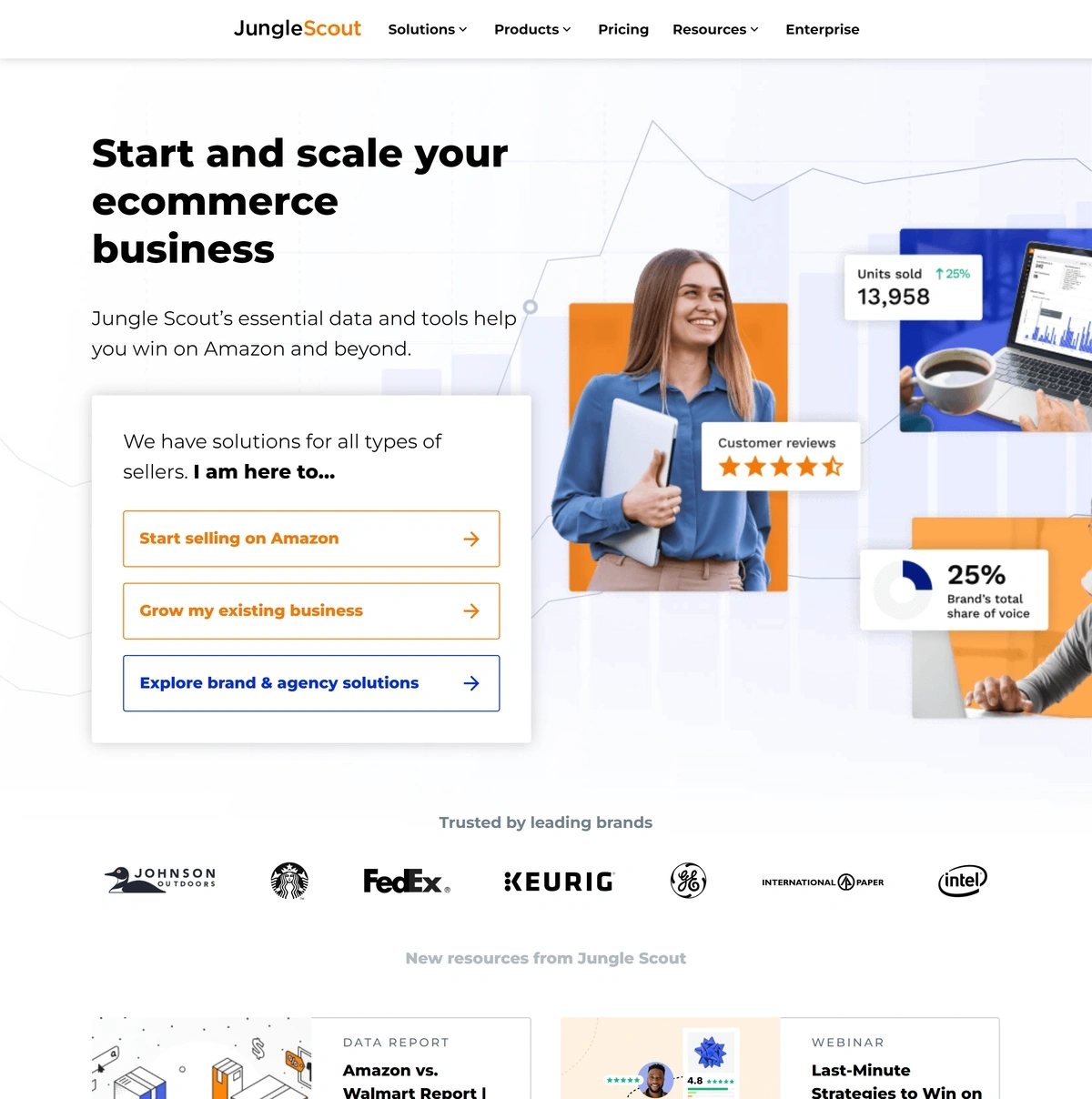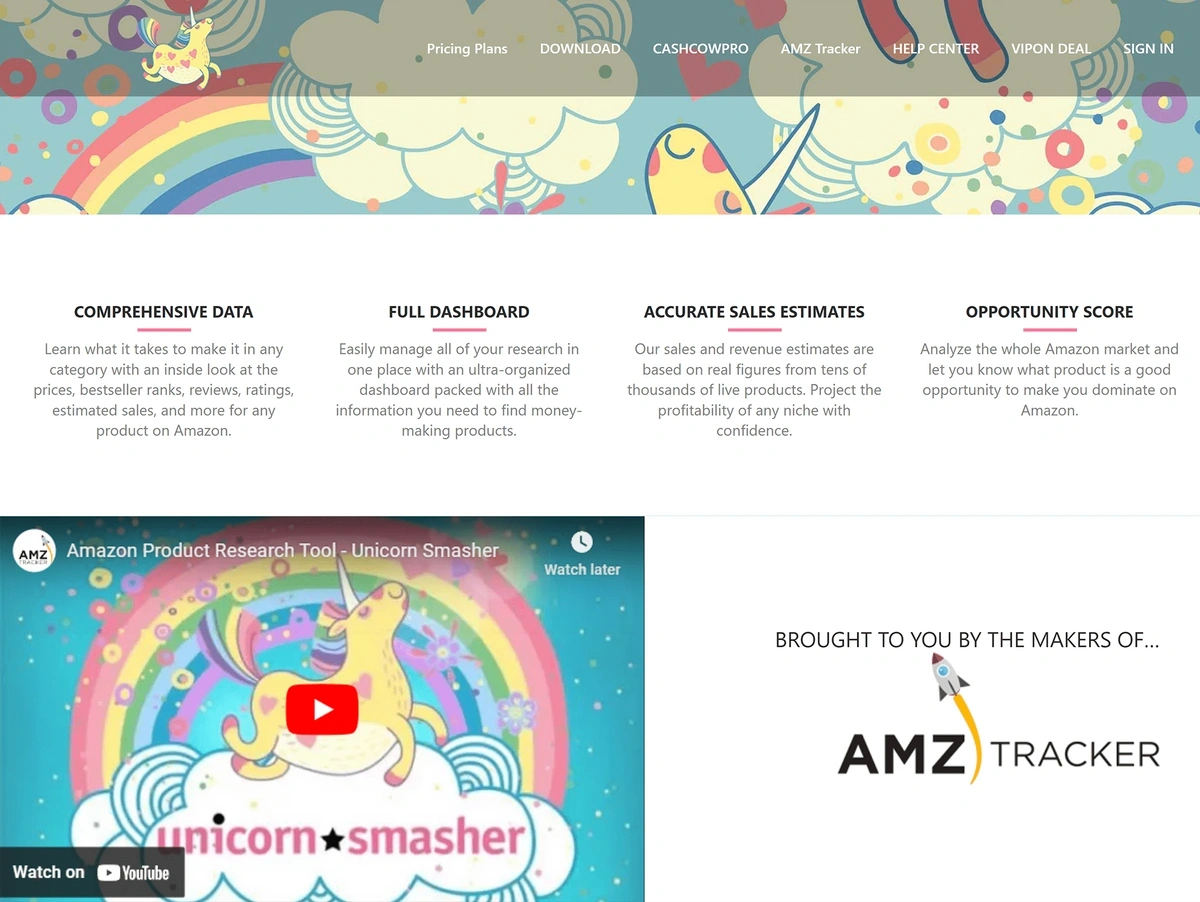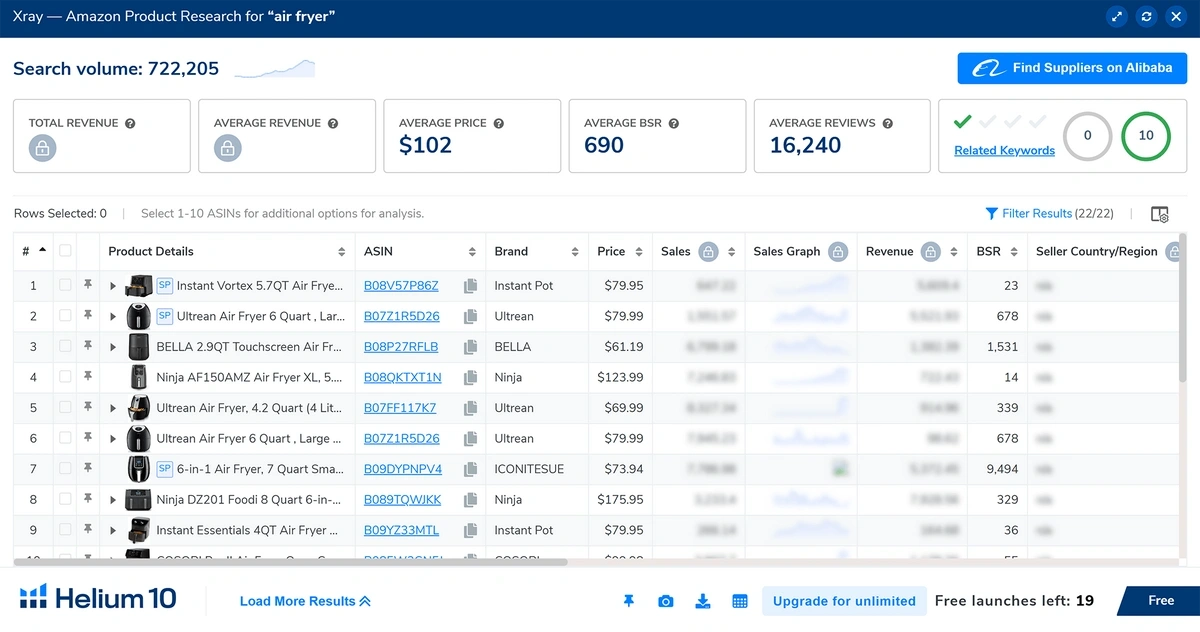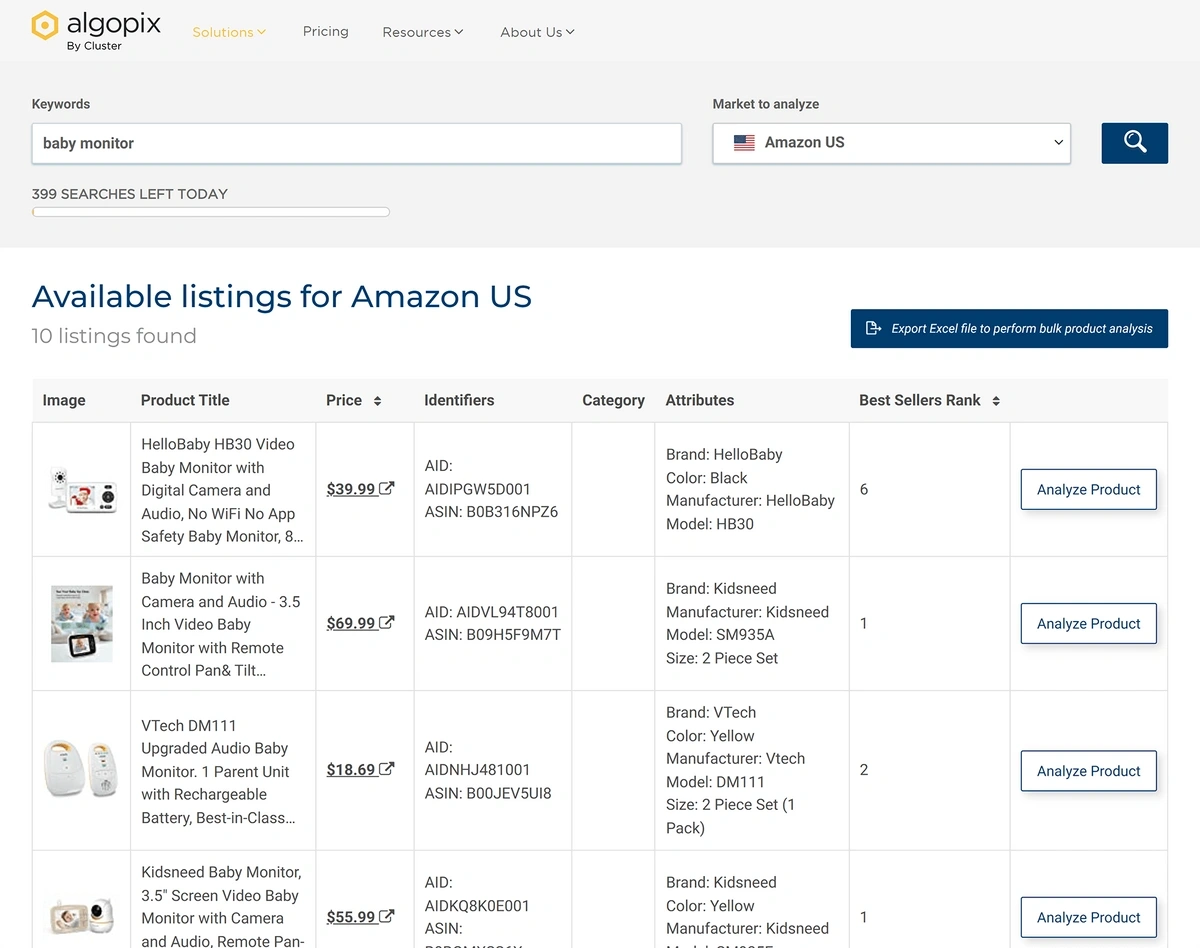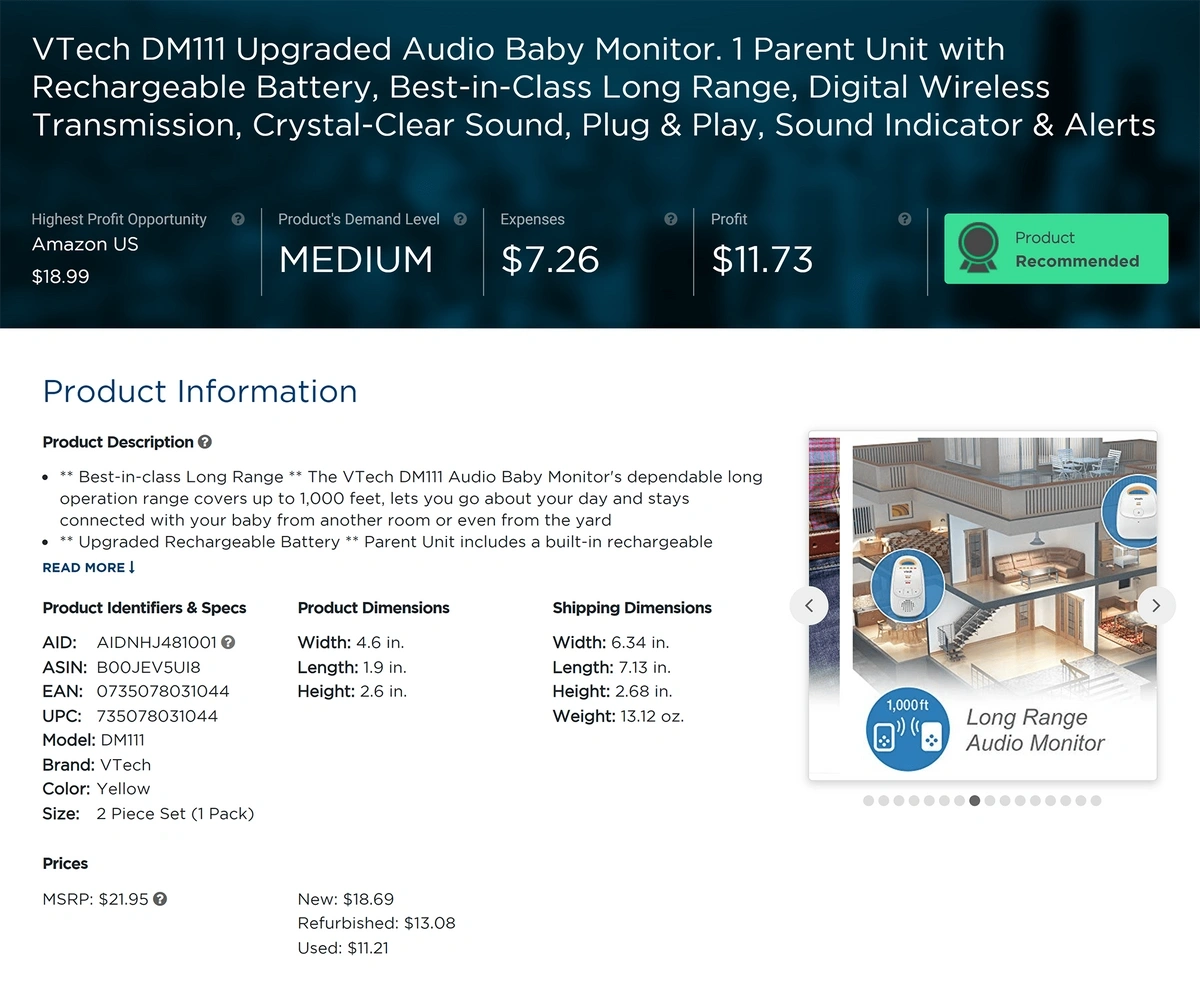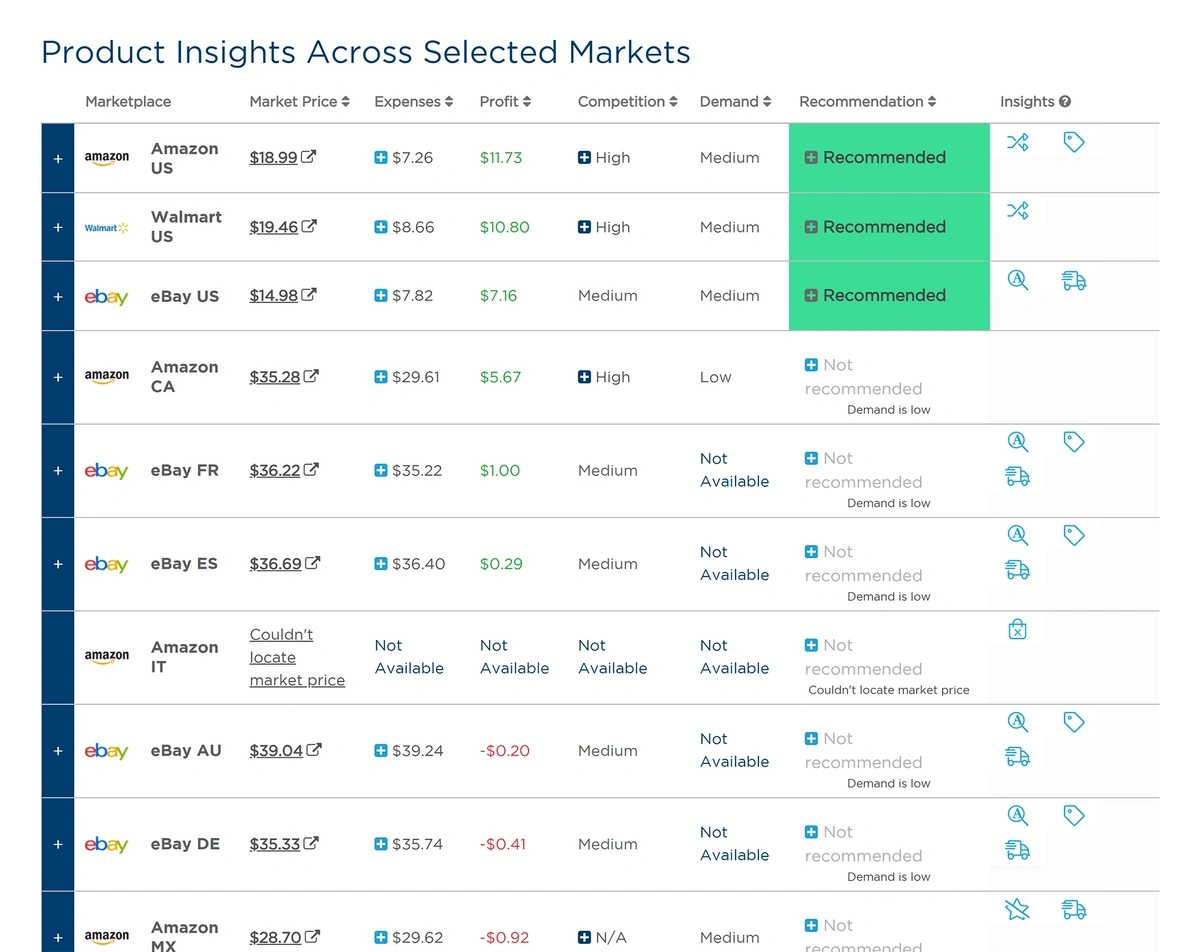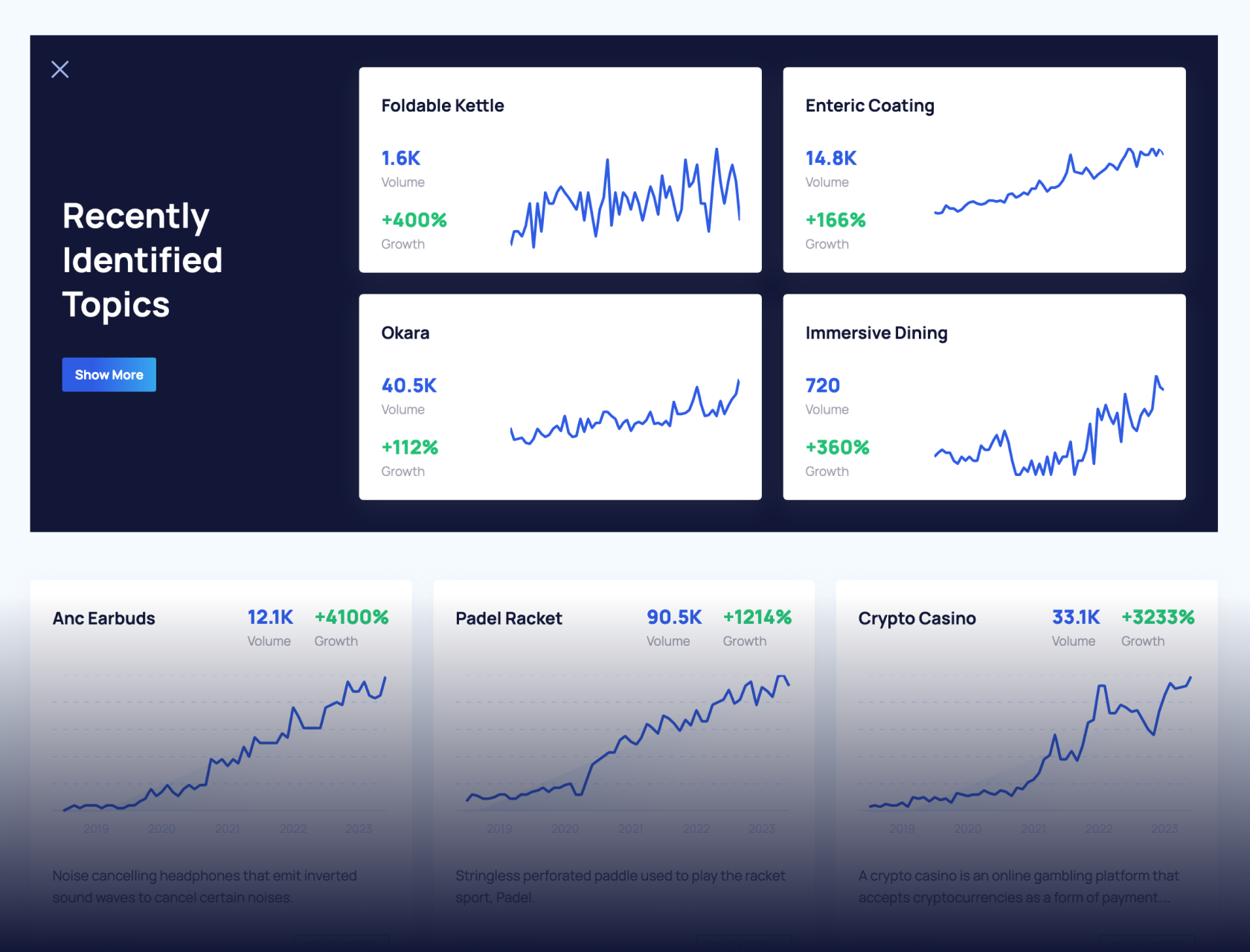
10 Top Ecommerce Product Research Tools (2024)
There are plenty of tools that make it easy to find new product ideas.
But how to do you choose the right one for you?
In this post, we'll review the top ecommerce product research tools on the market.
1. Exploding Topics
Most product research tools make product recommendations based on sales data from the past.
This means that you may launch a product that's already peaked.
We wanted to take a different approach and help serious ecommerce business owners discover products with future growth potential.
Specifically, Exploding Topics analyzes Google Search volume for a specific product from the past several years. And uses AI to project growth into the future.
There are two main advantages to using this approach:
- Google search data is much more reliable than just looking at a handful of suppliers' sales. Chances are that if people consistently search for the product on Google, there's decent demand for it.
- You'll see extended search trend history for each product keyword (from as far back as 15 years to as short as three months). This is a much better predictor of a product's long-term growth potential than, say, sales data from the past seven days.
So if you’re planning to put a product into R&D for several months, there’s a good chance that demand will not only exist, but also have increased by the time you’re ready to launch.
How to Use Exploding Topics Pro For Product Research
Exploding Topics Pro has three key features that makes it super easy to identify up and coming products before they take off:
- Trends Database: This is a database of over 13,000 manually vetted trends to help you discover the most promising trending topics you didn’t know about.
- Trend Search: If you’ve heard of a product, niche, or competitor company and want more information on its trend history, this feature allows you to create a report on the fly.
- Trending Products: A subset of the trends database enriched with data from Amazon.
Let’s discuss how to use each of these features in greater detail below.
Trends Database
The Trends Database helps you discover emerging products that you didn't even know existed.
Each of the 750k trends in the database is a keyword (company names, products, etc.) that was originally discovered by AI and then manually approved by a human research analyst.
If you want to get even more specific, you can filter by status (Exploding, Regular, and Peaked) as well as the time period (e.g.,past year, past 6 months, next 12 months etc.).
When you find a trend that interests you, you can click “Track Topic” and create a Project to follow it more closely.
For example, if my store is in the maternity care space, I might want to track the company Elvie and add it to a Project I created called “Ecommerce Companies.”
This way, I won’t miss up and coming competitors and I can also steal some of their product ideas. The marketing team can also dive into Elvie’s marketing strategy and research why it has experienced explosive growth.
Or, if I found a new product idea, like Rice Shampoo, I could add that to another Project like “Ecommerce Products.”
This makes it easy to quickly gather a list of trending products that you can discuss with your team and research in more detail.
Trend Search
After building out the Trends Database, we realized that you might have heard of a product that's not in the Trend Database, yet you still need trend data on that topic.
So we built Trend Search so that you can instantly create a trend report on any topic. Simply type in the keyword (brand name, product, etc.), and you’ll receive a report on the trend. For example, if you heard about "jogging strollers," you could type in that keyword and instantly create a report:
As you can see, this topic has already peaked, so it’s probably not a product you would want to launch.
Trending Products
This is our database of thousands of products that are currently trending. And that shows signs of long-term growth in the future.
You can even drill down into specific categories (health, home etc.) to find trending products in your specific niche.
2. Sell The Trend
Sell The Trend is designed to make it easy for dropshippers to manage the entire ecommerce business from a single platform.
So in addition to its product research tool, Sell The Trend also offers marketing tools, store automation, a supplier database, and automated order fulfillment.
Zeroing in on its product research tool, Sell The Trend's NEXUS Product Explorer uses AI to uncover various products and then provides detailed information like:
- Number of Orders: This is the total number of orders recorded from the Aliexpress suppliers that Sell The Trends is tracking.
- Product Cost: This is the cost from their suppliers.
- Selling Price: Average shop listing price from the sites they're tracking.
- Profit margin: Calculated as profit margin = product cost - selling price
- Total Sales: Total sales generated from all the suppliers they are tracking for that particular product.
- Number of Suppliers: This is the total number of suppliers that Sell The Trend partners with that are selling the product.
- Number of Stores Selling: This is the number of dropshipping stores selling the product from the stores that Sell The Trend tracks.
It also offers a product insights feature to gauge competition and other factors:
Sell The Trend connects with ecommerce platforms like WooCommerce and Shopify, so you can add any product you see with one click to start selling it. It also offers a Chrome Extension that allows you to import products directly from AliExpress.
Another interesting feature is its Store Intelligence Tool. This tool lets you add any Shopify store URL (that the owner hasn't blocked) and identify insights like:
- Top selling products
- Average product price
- Estimated tech spend
How Sell The Trend Gathers Data
Sell The Trend's product recommendation tool scans sources like Amazon, AliExpress, CJ Dropshipping, and other marketplaces. Then, Sell The Trend's algorithm makes product recommendations based on the data it finds (e.g., orders, profit margins, etc.).
It appears that the longest it tracks data is six months, which might make it difficult to distinguish fad items from promising trends. Therefore, it's best for dropshippers rather than enterprise ecommerce brands that plan to put a product in R&D for several months.
3. Niche Scraper
Niche Scraper is a bot that scrapes thousands of products to provide new entrepreneurs with winning product recommendations.
With each product, you’ll also have access to a variety of different metrics, including:
- Competition Score: Calculated based on the number of different buyers on AliExpress
- AliScore: Combination of growth rate, competition, and demand
- Growth: The purchase trend over the last seven days
You can also filter by product category, growth trends, competition, and other factors.
Another feature is the Shopify scraper which analyzes Shopify stores and shows detailed competitor product insights like which products were recently added and purchase history.
The team also offers a selection of hand-picked product ideas that they believe are winning products. For each of these products, they offer detailed insights like:
- Sale price
- Purchase price
- Profit margins
- Supplier links
- Facebook ad ideas
- Product description
- Other stores selling the product
Finally, it also has a Store Analysis tool that shows the top-performing Shopify stores and their most popular products. It also shows interesting metrics like revenue, average order value, estimated monthly traffic, and more.
How Niche Scraper Gathers Data
The product scraper analyzes various AliExpress products and uses an "AliScore" to determine which ones to add to the product recommendation list.
The AliScore is a combination of various metrics such as:
- Daily sales trajectory from the past seven days
- Product competitiveness which is measured by the number of stores selling it versus the number of sales
Again, this product recommendation tool is designed to help dropshippers capitalize on fads as the data is based on just the past seven days. Therefore, it's not really designed for larger ecommerce stores that are focused on long-term growth.
The hand-picked products undergo similar analysis, though the team also finds live Facebook and TikTok ads of the product to provide real examples of other stores marketing them.
For some products (about one per day), the team also runs ads to test how audiences respond.
4. EcomHunt
EcomHunt is a product discovery tool to help dropshippers find the right products at the right time. It offers three main features:
- Product Database: This is a database of thousands of products that shows detailed information like profitability, engagement, and links to dropshippers selling those products.
- Ecomhunt Get Lucky: This pulls individual products from the product database that fit the following filters:
- Trending (the topic is trending upwards via Google Trends)
- It's high margin
- Top score (Ecomhunt score calculated based on Google Trends, Aliexpress interest, low visits, and margins)
- Low visits (products with few visits on the Ecomhunt platform in the last 30 days).
- Ecomhunt LIVE: This is a list of 2,300 products that are trending upward and provides 30 day engagement history on each product and the countries it's trending in.
- Ecomhunt Tracker: The product tracking tool allows you to track performance metrics and monitor sale performance for each product.
Here's a snapshot of the information available in the product database:
Ecomhunt also has a chrome extension that allows you to inspect competitor stores and their products.
How Ecomhunt Gathers Data
Ecomhunt uses social media engagement data to find popular products, and then a team of product researchers looks at which ones are receiving the most sales on various top ecommerce stores they're tracking. From there, the most promising products are added to the product recommendation database.
It's also worth noting that Ecomhunt specifically looks for new products. So it's not designed to help ecommerce brands analyze long-term trends.
5. Dropship Spy
Dropship Spy is offers three main features to help you find winning products:
- Social Proof Products: This is a database that takes the 2500 top-selling products from the suppliers that Dropship Spy works with (across eBay, Amazon, and AliExpress) and ranks them by engagement (a score calculated based on likes, views, and shares) across Facebook, Instagram and TikTok.
- AliExpress Hot Products: This is a database of the current highest-selling products. It includes a sales trend graph that tracks sales from particular suppliers for the past four months.
- AliExpress Winners Research: You can search and analyze any product on the Aliexpress platform and view sales, profit margins, and other details.
Dropship Spy also has a selection of other tools that make it easy to streamline your entire ecommerce marketing strategy, including:
- Video ads
- Ad copy
- Audiences
- Relevant influencers
You can also connect directly with vendors to sell your products.
How Dropship Spy Gathers Data
Dropship Spy gathers its data (sales, profit margins, etc.) by tracking its suppliers' product data from the past four months of data. It also examines social media advertisement engagement across Facebook, Instagram, and TokTok to calculate each product's engagement score.
6. Thieve
Thieve.co is a product finder for AliExpress that takes a unique approach to ecommerce product research.
Rather than just selecting the highest-selling products across a set of suppliers, it curates a collection of products recommended by creators, like bloggers, photographers, and designers.
For each product, you'll be able to see the price, total sales, product rating, and likes. By default, the dashboard will order the products by "Trending."
Thieve also has the following tabs for more detailed product research:
- Niche: If you sell a particular niche, this tab will show you keyword trends and niche analysis, like influencers in the space, average profitability, competition, and CPC data.
- Keywords: This tab shows you the trending search volume pulled from Google Trends for various keywords (both product names and niche keywords) and predictive search volume for the next three months.
- Store Search: This allows you to search ecommerce stores and shows you the estimated monthly sales of the store (pulled from third-party sources like Oberlo and DSer) as well as engagement data like social media likes. It includes a link to the "best sellers" product as well.
How Thieve Gathers Data
Thieve is designed specifically for AliExpress sellers, and its key differentiator is that it starts by analyzing products suggested by creators (like bloggers, designers, and photographers). Then, its algorithm scans those products for various metrics like recency, popularity amongst the Thieve audience, and other conversion metrics.
Therefore, the data is sourced primarily from the Thieve ecosystem.
7. JungleScout
JungleScout is a platform for both beginner and established Amazon sellers, and it has plenty of different tools for ecommerce product research, including:
- Product Tracker: After finding a product you're interested in, the Product Tracker lets you track key metrics like units sold, rank, inventory, and price. You can also group products by category and view a single spreadsheet-like dashboard with real-time data on the above metrics.
- Opportunity Finder: This analyzes Amazon keyword search data to help you identify opportunities for new products and niches. In addition to providing you with search volume, 30 day, and 90 day trends for each keyword, you'll also see a competition score, average monthly units sold, and seasonality scores.
- Product Database: This allows you to search Amazon's 475 million products with filters like product reviews, price, rank, sales, revenue, and ratings.
- Category Trends: This feature can track the top 100 products of any category or subcategory on Amazon. You'll be able to see historical trend data from sales to reviews.
- Rank Tracker: This tool allows you to monitor keyword rankings over time. You can use it to reverse-search a group of ASINs and see historical keyword performance data to discover which keywords are influencing you and your competitors' listings.
Jungle Scout offers a selection of other tools to help you with marketing automation, inventory management, and more.
How JungleScout Gathers Data
JungleScout’s product database data comes directly from the Amazon API, and it takes a unique approach to product recommendations.
Rather than aggregating various metrics and telling you which products are “the best,” the database contains a variety of metrics and then allows you to sort by various metrics like:
- High demand and low competition
- High demand and bad marketing
- Good demand and poor product quality
- Good return on investment
- Max/min price
- Max/min rank
- Max/min reviews
- Max/min ratings
You can also track product performance over an extended period of time in the Product Tracker.
8. Unicorn Smasher
Unicorn Smasher helps automate Amazon product research by providing detailed product information.
Simply type in the category or keyword for the product you want to sell, and the Unicorn Smasher's extension will show you the following metrics for each search result:
- Number of sellers
- Variations
- Estimated sales
- Estimated revenue
- Reviews
- Ratings
For example, if you are interested in selling air fryers, you can see a selection of air fryers and the abovementioned metrics for each one.
While the Chrome extension is a free tool, Unicorn Smasher also offers a paid platform that gives you more detailed information, such as:
- One-click Amazon product information
- Complete data board
- Sales forecast
How Unicorn Smasher Gathers Data
While they don’t specify how they gather data, it’s probably gathered from Amazon’s API. Unicorn Smasher is unique from the other tools on this list as it isn’t designed to give explicit product recommendations. Instead, it’s designed to let you find more metrics for a product you’ve already discovered.
9. Helium 10
Helium 10 is a full-service platform for Amazon sellers and offers tools for everything from product research and listing optimization to analytics and marketing tools.
Focusing on its product research capabilities, Helium 10 offers the following tools:
- Black Box: This feature makes it easy to quickly find different products to sell and filter by geographic location, competition levels, price range, and monthly revenue.
- Trendster: This price tracking feature measures seasonality and other factors to evaluate products.
- XRay: This is their product analysis feature that provides product-specific metrics like search volume, average price, average BSR, and average reviews. Premium users can also unlock total and average revenue estimates. It is compatible with Amazon and Walmart products.
It also offers a Chrome Extension to access these tools directly from your browser while researching products.
In addition to product research, it also offers the following keyword research tools:
- Cerebro: This is a reverse ASIN/Product ID lookup tool
- Magnet: This keyword planner helps you find keyword data from Amazon and Walmart searches.
- Misspellinator: This tool finds commonly misspelled words so that you can capitalize on these low-competition keywords.
In addition to these product research tools, Helium 10 also offers plenty of other tools for marketing, listing optimization, analytics, and more.
How Helium 10 Gathers Data
Most of Helium 10's data comes from Amazon's API.
Helium 10 is also structured similarly to JungleScout as its main product database (Black Box) allows you to filter all Amazon products by various metrics like review count, review rating, best seller ranking, and more. So instead of telling you which products you should purchase based on an internal algorithm, you can just search based on various filters.
Regarding other data like performance, sales, and keyword search volume estimations, they have a data team that uses AI and machine learning to calculate these numbers. However, there isn't specific information about where that data is gathered from.
10. Algopix
Algopix is a product research tool for Amazon, eBay, and Walmart. Unlike many of the other tools on this list, it is specifically designed for product research and offers both product discovery and analysis tools to help you find the most profitable products.
On the discovery side, you'll be able to find products with either the:
- Product category analyzer
- Keyword discovery tool
With the product category analyzer, you can search by various categories in specific countries and even the brand name. Or, if you already have a specific product in mind, you can type it into the keyword discovery tool directly.
Here's an example of a broad keyword search:
Once you've found a few products of interest, you can analyze them with the Single Product Analyzer feature.
This provides information like:
- The marketplace with the highest profit opportunity (e.g., eBay, Amazon, etc.)
- Product demand level (calculated by product searches and product sales across several markets)
- Average expenses (shipping costs, marketplace fees, taxes, purchase costs, etc.)
- Average profit (average sale price minus average expenses)
All these metrics are calculated based on the averages of various products across eBay, Amazon, and Walmart. Of course, this means the accuracy of each calculation depends on how much data is available inside the platform.
Algopix also offers a store analyzer that makes it easy to search by Seller ID and see inventory analysis.
It offers a free plan with many of the same features as the paid plans, though with limited monthly searches.
How Algopix Gathers Data
Algopix gathers data from various APIs, and you can read more about it in each of these guides:
From there, it aggregates all of the data for each metric shown.
This makes the data fairly accurate, though it isn’t always accessible for every product.
Conclusion
As you can see, there are plenty of different product research tools, but they tend to be ideal for different use cases.
If you’re starting a dropshipping business and want a simple tool that automates the entire process for you, something like Sell The Trend or Jungle Scout might be a great solution to help you quickly get started.
However, if you’re building your own ecommerce products or you have more of a long term vision for your online business, you might want to use a tool like Exploding Topics that leverages a broader data set (Google Search volume) to help reveal longer-term trends.
Stop Guessing, Start Growing 🚀
Use real-time topic data to create content that resonates and brings results.
Exploding Topics is owned by Semrush. Our mission is to provide accurate data and expert insights on emerging trends. Unless otherwise noted, this page’s content was written by either an employee or a paid contractor of Semrush Inc.
Share
Newsletter Signup
By clicking “Subscribe” you agree to Semrush Privacy Policy and consent to Semrush using your contact data for newsletter purposes
Written By


Josh is the Co-Founder and CTO of Exploding Topics. Josh has led Exploding Topics product development from the first line of co... Read more

